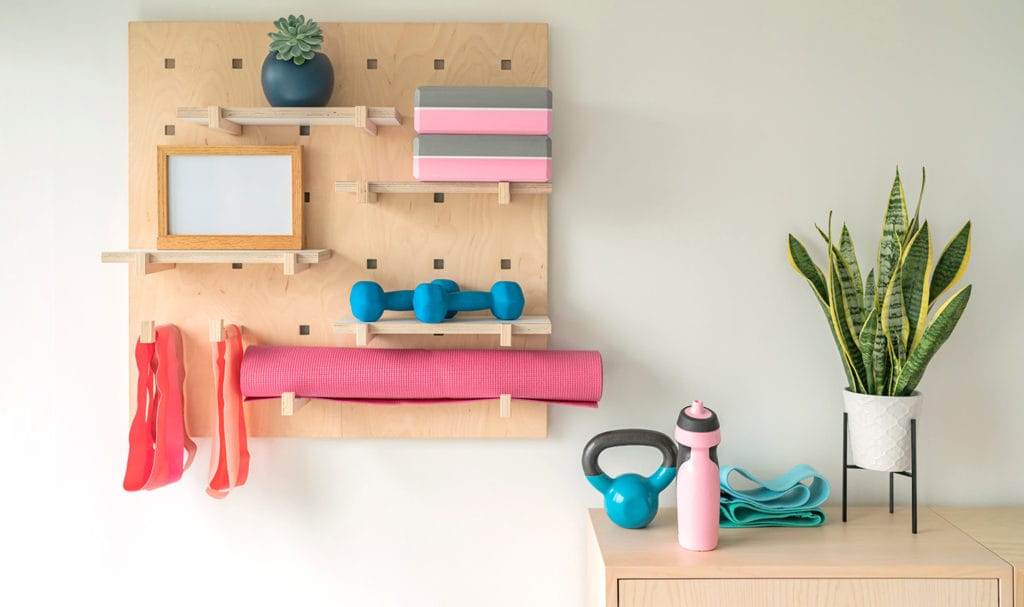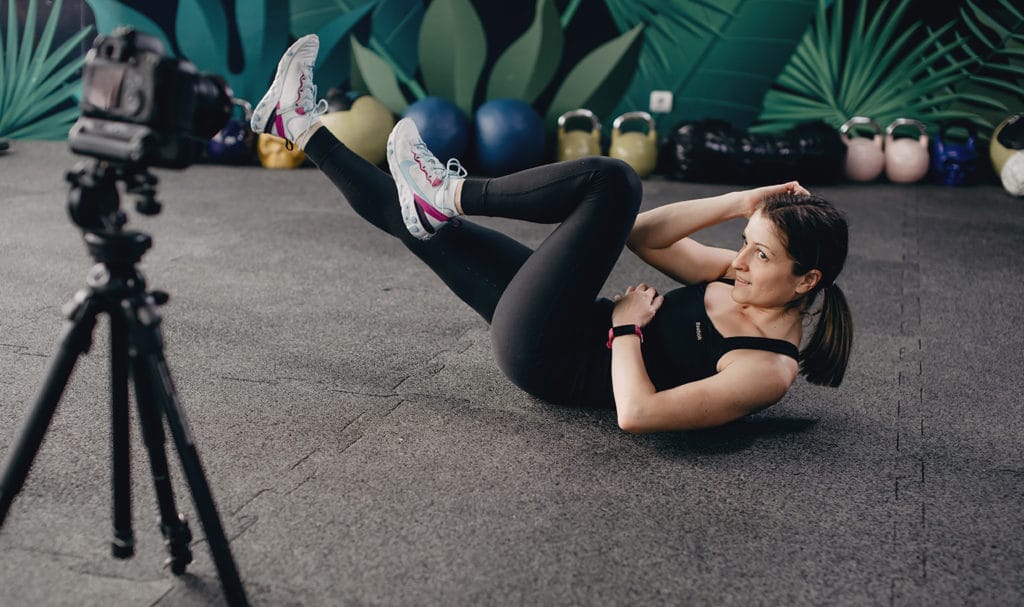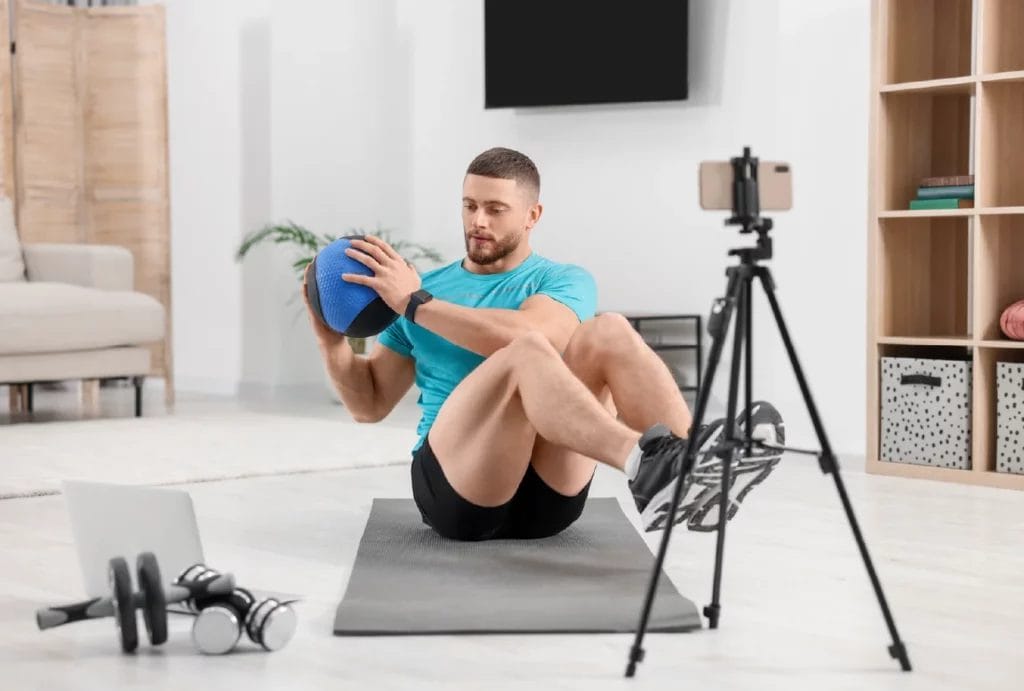- Last Updated:
- 2/12/2024
- Chelsea Ramsey, ACE CPT
Grinding away at the gym, training 5 a.m. bootcamps and 7 p.m. clients with awkward blocks of time in between is so 2017.
Over the past several years, many individuals switched to online workouts for comfort and convenience alone. This opened up new opportunities for personal trainers who also want to take control of their schedules and work when it works best for them.


Evaluate What You Need To Be an Online Personal Trainer
The first step to becoming an online personal trainer is to make sure you’re qualified to be a trainer in general. In other words, get your personal trainer certification.
If you’re currently certified and training in person — awesome! You’re already one or two steps ahead. If you’re able to switch some or all of your current clients to a virtual program, that will also fast-track your transition.
Some of the factors to consider as you try to become an online trainer:
- What experience or special qualifications do you have?
- Do you want to train online only, or will you offer hybrid options?
- Will you keep any in-person clients? Would any make the switch to virtual?
- Do you have the space and tools to work from home? (Like reliable internet, filming equipment, or exercise equipment?)
- Do you have a niche (ideal clientele) in mind?
- What do you need monetarily to make the switch to virtual?
- Do you have an end goal or progress goals?
- Do you have a business plan?
- How do you plan to market your online personal training options?
Pro Tip: Making a basic, skeleton personal trainer business plan can help you answer all of these questions!

Make a Plan to Transition Your Business From In-Person to Online
A preliminary business plan can help you prepare your transition from in-person to online training. Or if you’re starting from scratch, it can help you determine if you want to do a mix of in-person and online training as well.
Set up a generalized timeline and/or goals you want to achieve as part of your plan to become an online trainer. For example:
- I will reduce my in-person training to Mondays, Wednesdays, and Fridays only by June 30th
- I want to have 10 consistent virtual clients before leaving the physical gym
- I need to make $ dollars a week in virtual sales to move out of the gym
If you already have regular in-person clients, keep them informed of your plans and their options. Since word of mouth referrals are so important to gaining new business as a personal trainer, make sure to maintain your positive client relationships.
Along with taking care of your current clients is the need to know how you will work with them and new clients going forward. Which takes us to the next step: logistics.
Takeaways
- Get a personal trainer certification
- Establish goals
- Make a plan

Anticipate Online Personal Training Logistics and Management Needs
Becoming an online personal trainer comes with a certain level of client and business management tasks. Not only are you your own boss — you’re also your scheduling manager, customer service rep, and everything else.
Business logistics you’ll need to figure out:
- Client scheduling
- Time management
- Payment processing
- Communication
- Operating hours
- Work-life boundaries (for instance, being available by text 24/7 is probably not sustainable long-term!)
All of these things can feel like a lot, especially on top of workout programming, so being organized and having a plan for time management can help. Reserve certain days and times for tasks like:
- Client calls, emails, and texts
- Workout programming
- Progress reviews
- Marketing and advertising
- Miscellaneous business tasks, like paying bills
- Your own professional development
Pro Tip: You can streamline these things even more with the help of client management software.
Client management software (also known as client relationship management or CRM software) are tools that can help with scheduling clients, tracking workouts and other habits, payment processing, and more.
Examples of CRMs geared for online personal trainers are Trainerize, TrueCoach, and WeStrive. They can be a big help with scaling your business as you grow.
Takeaways
Establish your business tools:
- Personal trainer software
- Calendars and schedules
- Payment processors

Meet Legal and Liability Considerations for Online Personal Trainers
There are no set laws requiring personal trainers to carry liability insurance or to collect specific documents from clients… However! Without these things the blame for accidents or health events could be pinned on you, leaving you responsible for medical bills, legal fees, and more.
So for your own and your clients’ safety and protection, adopt widely accepted best practices for in-person and virtual personal trainers everywhere:
- Carry personal trainer liability insurance
- Conduct health history questionnaires
- Conduct risk assessments
- Obtain informed consent/liability waiver forms
Takeaways
- Get liability insurance
- Use liability waivers
- Use health history forms / conduct risk assessments
Coverage you want to have as an independent contractor or a self-employed fitness professional includes:
- General liability for third-party slip-and-fall injuries or property damage
- Professional liability for claims that you gave improper advice (sometimes called “malpractice” or “errors and omissions”)
- Products-completed operations for post-session problems like a client sustaining a back injury while lifting on their own, due to an improper technique that you taught them
- Personal & advertising injury for non-physical damage claims, like libel, slander, or false advertising
- Damage to premises rented to you for property damage to a space you rent for work
- Medical expenses limit, which is no-fault coverage for minor medical expense claims from third parties (regardless if you’re at fault)
Insurance Canopy combines the above coverages into one convenient base policy. You can increase protection for your business with cyber liability coverage, gear and equipment coverage, and diet and nutrition coverage as well.
- Gear and equipment coverage (aka “inland marine”) works to keep your business in business, by protecting your movable business equipment against theft or damage.
- Cyber liability can protect your business in the event of a data breach, like if your client data gets hacked, as well as other cybercrimes.
- Diet and nutrition coverage is intended to cover you in the event of a claim related to non-medical nutritional guidance you provide
No matter what coverage you choose, policies for fitness professionals from Insurance Canopy go with you wherever you train — online, in person, or both!

Create Effective Workout Programs for Online Clients
To really get going, your remote personal training business needs a good virtual workout program or two. Knowing the ideal clients you want to work with should determine the kinds of plans you create.
Key elements of crafting an effective workout plan:
- Make it engaging: Know the client
- Make it relevant: Know their goal, know their starting point
- Make it achievable: Set clear expectations with realistic mini goals along the way
- Make it specific: Provide detailed directions with applicable exercise alternatives
- Make it easy to progress: Include logical progressions and recovery times
Studies have shown time and again that those who enjoy their workouts are more likely to stick with them. And when it comes to fitness, consistency is key!
Find a Niche
You can try to appeal to a wide variety of clients or provide general fitness services, but this approach may make it harder to stand out in the vast online universe. Instead, zoom in on some specific types of niche clients or workout specialties.
Time-of-life demographics/special focuses, like:
- Maternity and more; fitness for the first, second, third, and fourth trimesters
- “Baby and me” plans; how to keep fit and healthy while also caring for babies and toddlers
- Functional fitness for maintaining independence through retirement and beyond
Health, recovery, and overall wellness focuses for special populations, such as:
- Functional fitness for chronic pain sufferers
- Delaying and easing arthritis symptoms through movement
- Strength training for those with a history of disordered eating
Sport-related focuses including things like:
- Pickleball for all
- Marathon training
- Rec league basketball training
Super specific focuses, like:
- Strength training for adults with artificial knees
- First-time fitness competition training for 40-and-over moms
- At-home core and cardio for agoraphobia
When you know your focus and the kind of client you want to work with, you can start building out your programs.

Account for Various Online Workout Program Components
Know what formats and/or environments are most appropriate for your clientele. (You wouldn’t create an at-home workout plan that requires professional gym equipment or give new parents lengthy workouts six days a week, for example.)
Additional aspects of program design to analyze:
- Personalization: How much or how little will you personalize each client’s plan?
- Face time: Whether you will offer hybrid in-person/online options or online only.
- Phone calls: How many live video or audio phone calls will you provide (if any) and how long the sessions will last?
- Grouping: Whether you will offer 1:1 programs, group programs, or both.
- Communication: How often you’ll communicate with clients directly, and how (text, phone, email, etc.).
- Content and distribution: What kind of content will you provide (individual exercise videos, workout routine videos, spreadsheets, etc.)? And how will you get your workout program to your clients (trainer software programs, shared Google docs, printable PDFs via email, and so on)?
Build Your Workout Programs
Based on these components, you can then decide how you want to package and present your workout programs. Some options to consider as standalone or mix-and-match include:
- Create workout templates you can easily tailor to individual clients
- Produce overall program package templates
- Set up your exercise video library
- Design any needed nutrition guidance materials
- Develop any additional habit tracking materials
- Establish a method for any other client tracking and business tasks
- Make a schedule for live calls, video appointments, etc.
Takeaways
- Find your specific niche
- Establish program offerings and the scope of services you’ll provide
- Build workout plans: make them relevant, engaging, and logical for your clients

Market Your Online Personal Training Services
Getting the word out there about your services doesn’t just happen. Awareness, advertising, and sales can be hard work. You’ll need to build up those muscles in order to successfully flex them.
Create Your Online Personal Trainer Marketing Plan
You might already have inspiration and ideas about the brand you want to build and how to promote your virtual training business. If not, or if the creative side of marketing doesn’t come naturally to you, lean into online tools like Canva’s free premade templates or get low-cost help from online marketing professionals on platforms like Fiverr.
Your marketing plan should explain your plan to advertise and promote your business, including things like:
- Branding
- Logo
- Mission and vision
- Voice/tone and vocabulary
- Imagery
- Color schemes
- Target clientele
- User-friendly website
- Search engine optimization (SEO)
- Social media activity and engagement
- Live Q&A’s (question and answer sessions)
- Giveaways
- Challenges
- Surveys and more
- Networking
- Reviews and referrals
- Client loyalty program
Plus, the work you’ve already done, like finding your super-niche or establishing a unique program structure, will make the marketing process a little easier.
“You are unique. There’s no one else like you…because nobody else is you.”
-Art Rios
Other aspects of your marketing plan may include:
- Pricing, including things like bundled options and new client offers
- Value
- USP (unique selling point)
Pricing
How affordable are your services, what incentives or guarantees do you offer, what incentives do you plan to offer to attract new clients?
Examples:
- Buy 1 month, get 1 month free
- Refer a friend who buys a month of training and receive $20 off your next session
- Half the cost of the average in-person trainer
Value
What will the client get out of your programs, why should they spend their money on you vs an app like Centr or Nike?
Examples:
- Accountability and attention to your clients’ specific needs that apps can’t provide
- Flexibility to complete workouts on their own schedule, without the need to plan around a gym or an in-person trainer’s availability
USP
Your unique selling point (USP) is what makes you special, what you do better than anyone else.
Examples:
- Personality. Be your version of a fitness nerd, a motivational empath, a Badass who makes others feel like Badasses
- Experience. Maybe you had a personal experience where your needs weren’t met, so you’re providing that need now; or you spent 10 years as a backup dancer and now you teach pop choreo-inspired dance fitness
Takeaways
- Establish a brand
- Build a website/online presence
- Determine your USP – your ‘it’ factor
- Advertise your unique value

Review, Analyze, and Adjust
“The key to success is often the ability to adapt.”
-Anthony Brandt
To reach your ultimate goals, periodically assess how your online personal training business is doing overall. As part of this, you should set specific, measurable, time-bound goals — you’d do this for any client, so do it for your own business, too!
Talk to Your Clients
Gather feedback from your clients. Keep a record of that feedback. What do they like about your programming? What do they not like as much? Do they have specific suggestions or pain points like accessing their workouts or tracking their progress?
Do they feel like they are feeling and/or seeing results? Do you see your clients progressing? If not, you may need to take a look at how your programs are structured.
Analyze Your Online Metrics
Review the relevant aspects of your website, SEO, and social media marketing. Did you have ads? Did you run special promotions? How much traffic did your web content and social posts generate?
Reviewing this kind of information can help you decide if what you’re doing is working or if some tasks cost you more in time and/or money than they’re worth.

Sales Assessments
It’s probably the most obvious performance marker. Are you selling sessions? Are you gaining new clients? Are you keeping clients?
You could sell a record number of VIP packages one month but have no one renew their program with you the next. Some fluctuation is to be expected, but drastic changes or persistent trends probably warrant further investigation.
Regularly reviewing all these things against specific goals you want to hit over time will help develop your overall business plan as you progress. It’ll likely take several reviews and tweaks before you find the marketing tools, training programs, and messaging that work best for your business.
Takeaways
- Gather client feedback
- Review SEO and marketing metrics
- Review sales and trends
- Adjust and adapt as needed
FAQs About How to Be an Online Personal Trainer
Do Online Personal Trainers Make Money?
Online personal trainers should expect to make similar to what in-person trainers make, at least in the beginning. The average yearly income for personal trainers is between $46,480 and $51,270, per the U.S. Bureau of Labor Statistics.
As you become more established, with more passive income options thanks to virtual offerings, you could even reach $100,000 a year.
What Certifications Do I Need To Train Clients Online?
To train clients online, you’ll need the same certifications as you would when training clients in person. At a minimum, you should have a personal trainer certification and CPR (cardio-pulmonary resuscitation) certification.
Getting additional certifications can differentiate you from other online trainers, which can also boost your client attraction results.
How Can I Engage Clients in a Virtual Training Environment?
- Reach out regularly
- Be personable, ask questions
- Offer guidance and encouragement
- Create positive client rapport/relationships
- Include competitive and/or community elements
- Add gamified elements

Chelsea Ramsey, ACE CPT | Copywriter
Ohio-based copywriter and licensed insurance agent Chelsea Ramsey leverages her experiences as an American Council on Exercise (ACE) certified personal trainer, a role-playing game writer, and a former auto claims adjuster. She holds a bachelor’s in English from Ohio State University and a TEFL certification from Oxford Seminars. Before working at Veracity, Chelsea wrote for Zulily and trained clients at her local community center. She now writes to assist fitness professionals and entertainers in finding their ideal insurance policies.
Ohio-based copywriter and licensed insurance agent Chelsea Ramsey leverages her experiences as an American Council on Exercise (ACE) certified personal trainer, a role-playing game writer, and a former auto claims adjuster. She holds a bachelor’s in English from Ohio State University and a TEFL certification from Oxford Seminars. Before working at Veracity, Chelsea wrote for Zulily and trained clients at her local community center. She now writes to assist fitness professionals and entertainers in finding their ideal insurance policies.



